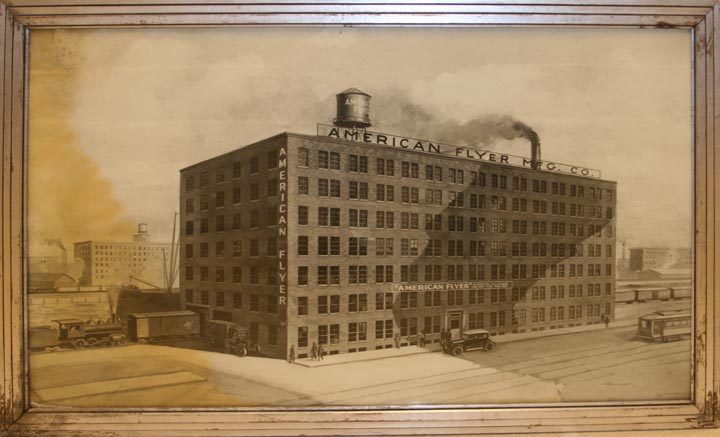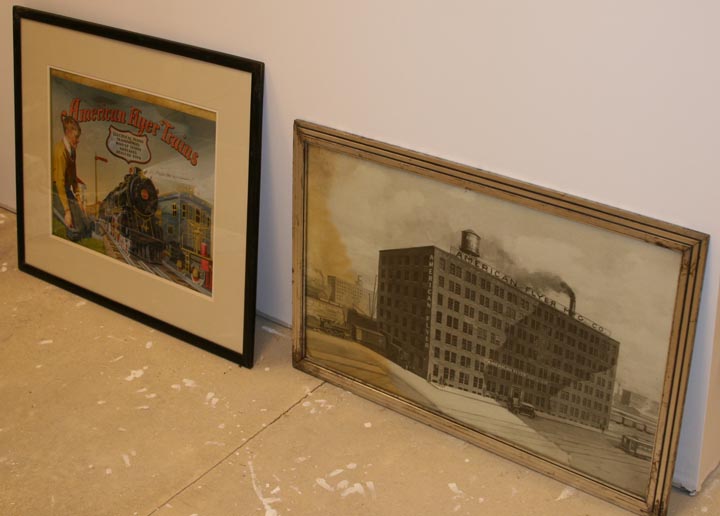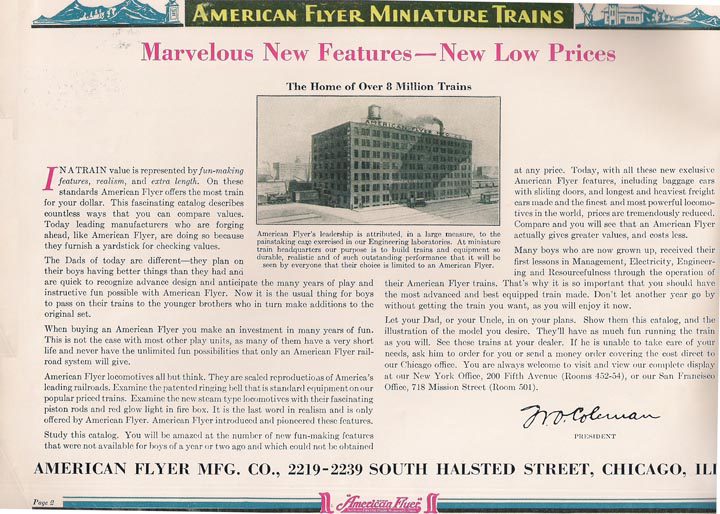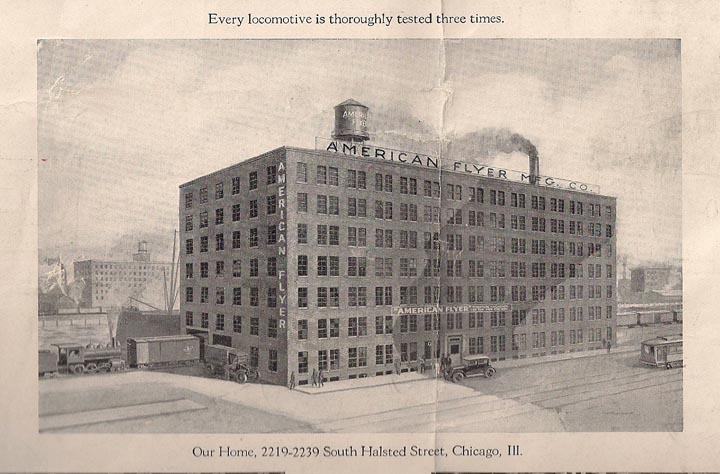American Flyer Factory Artist’s Rendition
BY OTIS B. DRINKWATER
This is a pen name. To contact the author, please mail Editor Bob Mintz
This item was acquired from the same collection as the 1930 American Flyer Catalog Artwork article.
At first my belief was that this item had not appeared in any American Flyer advertising. I and other collectors who viewed it after its acquisition, could not recall seeing this view of the factory previously. A couple of months after purchasing this work, one of my friends indicated that he had seen this image inside the cover of one of the 1930s catalogs.
I searched through my catalogs and sure enough, a small image of this work appears in the 1932; 1934; and 1935 catalogs on the inside of the cover. I thought to myself that this glorious piece of art could not have been produced for that tiny image, but was still at a loss. Then I purchased a 1924 American Flyer catalog. There at the center of the back of the catalog, was the first and only true image of this work that appears to have been used in an American Flyer catalog or anywhere else to my knowledge.
The image on the back of the 1924 catalog is approximately 3″ by 5″ and the image inside the front covers of the 1930s catalogs are even smaller. Additionally, the image came to me in a 1920s art deco style frame that was covered in silver gilt and there were no signs that the image had ever been out of the frame.
It is obviously an artist’s rendition of the idealized American Flyer factory. This is apparent in that there are no buildings on either side of the factory; the fact that the picture shows all forms of transportation; inclusive of a train in the loading dock area; a Mack Truck to the side; an automobile at the front entrance; a trolley to the right; more train cars to the right of the building; and finally; a ship docked at the rear of the building.
In examining the item after its purchase, I found that it did not appear to be an original piece of art, but instead that it appeared to be a photographic image of an original pen and ink drawing.
As with the original 1930 American Flyer catalog cover art, I knew that this item was in need of conservation/restoration. I could immediately tell two things about the image, first that there was a large water stain on the left side and second that the photograph appeared to be stuck to the glass.
Knowing that I did not have the knowledge or experience to do anything with this work, I left it as is and contacted a paper conservator. Within a week of purchasing the two items, they were taken to a paper conservator for restoration. The paper conservator agreed with me that this work was a photographic image and I helped to remove this image, while still attached to the glass, from the frame.
The paper conservator has indicated to me that they are not certain that they will be able to clean the water stain from the image, due to it being a photograph. Apparently, water staining affects the gel coat of the photograph differently than an original pen and ink drawing on paper. It was indicated to me that under the best conditions, the border of the water stain will be minimized so that the color contrast between the stained and un-stained area will match more closely.
As of my last conversation with the paper conservator, it was indicated that the image has been removed from the glass with minimal loss to the photograph and that the affected areas were present and could be re-attached to the photograph. The paper conservator also indicated that the image had been removed from its original mount/backing. It was indicated that the person working on the conservation was considering how best to proceed with trying to clean/minimize the water stained area.
Another interesting feature of the item is that it came to me in its apparently original 1920s era silver gilt/leaf covered art deco frame. The paper conservator is having an acquaintance restore the frame for me and have new glass installed. Although I hesitated at the new glass, it was explained to me that the new glass would be of a uniform thickness, be thinner, and allow for a small matte to be installed between the glass and image that would prevent the image from coming in contact with and sticking to the glass.
I am left wondering what was the purpose of this photographic image? Did this or the original pen and ink drawing originally hang in the American Flyer Factory on Halsted Street? Are there any other images of this size in existence? Does the original negative still exist?
As for the original artist of this image, it could be that it was done by Mr. Louis A. Paeth, for which my 1930 Flyer original catalog cover artwork is attributed. Mr. Paeth was the artist for the 1922-1924 catalog cover image and the first use of this image is on the back of the 1924 Flyer catalog. I was provided with some similar images of factory renditions that Mr. Paeth did and there are similarities. At this point, I don’t know and cannot say for certain. I did not consider the implications of who the artist was when taking these items to the paper conservator. I have examined digitally enhanced blown up images of the photos of the image prior to my delivery to the paper conservator and believe that there may be a hidden P (for Paeth) in the artwork, but I am waiting until the image is returned to make a final call, as it will be easier to tell from an actual examination of the image.
If anyone has more information about this image, please contact Bob Mintz.









